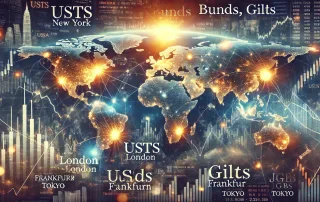What Iran and Israel’s Tensions Mean for Forex Traders

Iran, Israel, and Missiles—Oh My!
The Middle East is, once again, the kind of neighborhood you’d call a “fixer-upper.” Israel recently launched an airstrike that took out Hezbollah’s media relations chief, Mohammad Afif, and tensions are spreading faster than a Friday afternoon market rumor. But while the geopolitical scene is heating up, there are hidden opportunities for Forex traders who know where to look—and, perhaps, a few pitfalls for those who don’t.
This isn’t your average report of regional unrest. Let’s dive into the advanced trading tactics that help us make sense (and maybe a few pips) from this. After all, if you’re reading this, you’re not just some onlooker; you’re a trader looking for the game-changing insights that lurk behind these headlines. You’re like the Indiana Jones of currency—but without the hat. Let’s get you geared up.
Gaza Shakes, Markets Quake
Israel’s recent strike in northern Gaza, killing tens in a residential building, is more than a somber news piece—it’s a seismic move that could shake market sentiment. Here’s what most traders are missing: when regional turmoil flares up, it’s not just about watching oil prices or running to safe-haven currencies like the Swiss Franc or Japanese Yen.
A deeper, contrarian strategy is to use these moments to check correlations. It’s not the first instinct traders have when bombs are flying, but savvy Forex warriors look for correlation divergence between emerging market currencies and USD pairings. During moments of heavy turmoil, traditional correlations—like that of the Turkish Lira (TRY) or Egyptian Pound (EGP) to USD—can become untethered from typical market logic, offering opportunities to enter swing trades with risk-adjusted gains.
But here’s where the real magic happens: position trading. For those willing to hold their nerve, market turmoil can shift economic priorities in such a way that central banks in affected regions might adopt previously unannounced, dovish measures. This sets up amazing entry points for long-term players—the type of opportunities that more short-term traders miss while chasing headlines.
Iranian Hints: Trump and the Tea Leaves
Let’s talk about Iran for a moment. A headline about a meeting between Iran’s envoy and Elon Musk was swiftly denied by Iranian Foreign Minister Araqchi, and despite the murky PR, there’s much to unpack for traders. Tehran keeps hinting at opening the door for negotiations with U.S. President-elect Trump, despite a “maximum pressure strategy” that’s been like trying to squeeze toothpaste out of an already-dry tube.
But what should a Forex trader do with this soap opera? Here’s a not-so-obvious angle: volatility carry trades. While the FX world is currently obsessed with short-term gains, this news is about the long game. If Tehran makes real strides towards diplomacy, the Iranian Rial (IRR) could eventually stabilize—and for those trading exotic currencies, it’s worth looking at the potential carry benefits as the Iranian economy could get an eventual boost from a thawing international relationship.
In-Depth Insights: Be a “Fear Trader,” Not a “Fear Victim”
You know how some traders get caught in the panic cycle of breaking news? They over-leverage, chase moves, and generally turn every possible event into a reason to either blow up their account or blow out of trades too soon. Let’s be clear: if your first response to geopolitical tensions is to go full-on risk-off, you’re missing the nuance.
Instead, think like a “fear trader.” Recognize that while volatility spikes can disrupt sentiment, these spikes create opportunities for contrarian entries. One lesser-known approach is to use FX options volatility to hedge a directional trade in a fundamentally-driven pair. Essentially, you’re using the fear others have priced in as a kind of armor for your own trades.
Techniques You Won’t Hear Elsewhere: The PMI Angle
Another gem hidden in plain sight is how these tensions could influence the Purchasing Managers Index (PMI) in Europe, which often gets less focus when Middle East tensions rise. Here’s a tactic that sets pro traders apart: use PMI readings as a leading indicator of future EUR performance against commodity-tied currencies.
The reason? Middle East tensions often indirectly impact the supply chain metrics that feed into European PMIs, particularly through energy channels. This offers advanced traders an opportunity to anticipate drops or rallies in PMI data and position themselves accordingly in pairs like EUR/CAD or EUR/NOK, potentially front-running the majority of retail sentiment.
The Forgotten Tactics That Outperformed Wall Street Predictions
So, what’s the forgotten tactic I’ve been hinting at this entire time? It’s the power of narrative analysis in Forex trading—something big institutional players swear by, but most retail traders leave untouched. When news drops, most traders focus purely on price action, missing the broader context. But if you read between the lines—like how Iran’s repeated mentions of “negotiation” and “diplomacy” often coincide with strategic statements from European allies—you start to see not just what’s happening, but what’s being set up to happen next.
Imagine spotting a chance to enter on a weakening USD because you know that diplomatic overtures (even if currently rejected) often lead to a loosening of European banking regulations—which in turn allows more money to flow into currencies like the EUR or GBP. That’s how you position trade like a boss.
The Opportunities Hidden in Plain Sight
Today’s news is more than headlines—it’s an invitation for deeper analysis, a nod to the opportunities that emerge when markets are at their most irrational. Israel, Iran, turmoil, and negotiations all have their own roles in this intricate dance of geopolitics and economics.
Stay smart, stay strategic, and remember: what shakes the masses is often the very thing that quietly boosts your edge as a trader.
Want more insider analysis? Stay informed on market movements with exclusive updates here.
—————–
Image Credits: Cover image at the top is AI-generated

Anne Durrell
About the Author
StarseedFX delivers timely Forex news and market insights, thoughtfully edited and curated by Anne Durrell. As a seasoned Forex expert with over 12 years of industry experience, Anne turns complex market shifts into clear, engaging, and easy-to-understand updates.
From decoding the latest trends to writing her own in-depth analyses, Anne ensures every piece is both informative and enjoyable. If you found this article helpful, don’t forget to share it with fellow traders and friends, and leave a comment below—your insights make the conversation even richer! Follow StarseedFX for fresh updates and stay ahead in the dynamic world of Forex trading.






